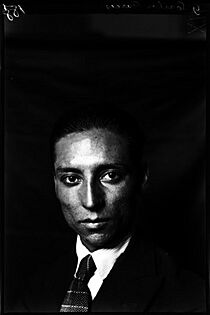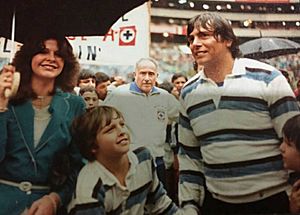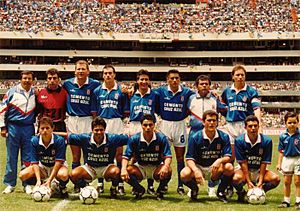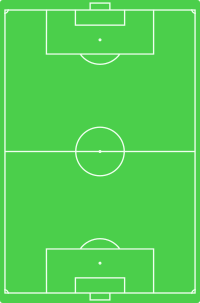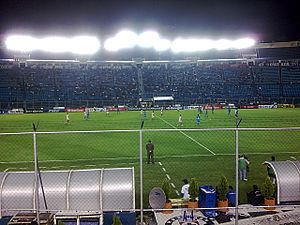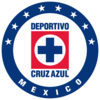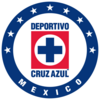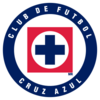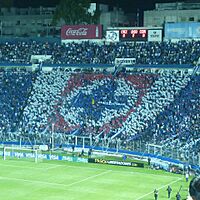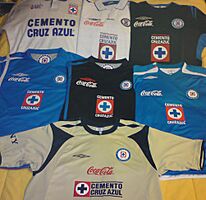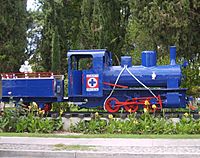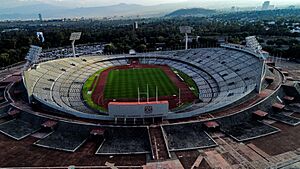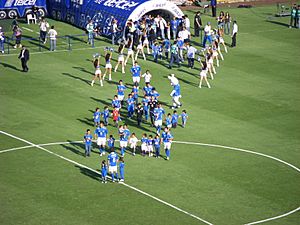Cruz Azul facts for kids
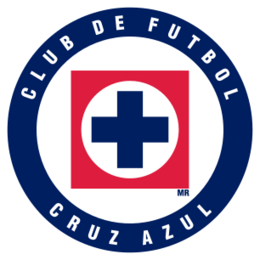 |
|
| Full name | Club de Futbol Cruz Azul S.A. de C.V. |
|---|---|
| Nickname(s) | La Máquina (The Machine) Los Celestes (The Sky-Blues) Los Cementeros (The Cement Makers) Las Liebres (The Hares) Los de La Noria (The Men from La Noria) |
| Short name | CAZ |
| Founded | 22 May 1927 |
| Ground | Estadio Olímpico Universitario (temporary) |
| Capacity | 58,445 |
| Owner | Cooperativa La Cruz Azul, S.C.L. |
| President | Víctor Velázquez |
| Head coach | Nicolás Larcamón |
| League | Liga MX |
| Clausura 2025 | Regular phase: 3rd Final phase: Semi-finals |
Club de Futbol Cruz Azul S.A. de C.V., usually called Cruz Azul, is a professional football team from Mexico City. They play in Liga MX, which is the top football league in Mexico. The club started in 1927 in Jasso, Hidalgo. In 1971, the team officially moved to Mexico City.
Cruz Azul has won many titles in Mexico. They have won nine league titles, four Copa MX cups, and three Campeón de Campeones trophies. They also share the record for winning one Supercopa de la Liga MX and one Supercopa MX.
Internationally, Cruz Azul is very successful. They have won the CONCACAF Champions Cup/Champions League seven times. This is the most important club competition in North American football. They share this record with another team. Cruz Azul was also the first team from CONCACAF to reach the final of the Copa Libertadores. This is the biggest club competition in South American football. They played in the final in 2001 but lost to Boca Juniors in a penalty shootout.
The team is known for winning three major titles in one season, called a "continental treble." They did this in the 1968–69 season. They won the Primera División, Copa México, and CONCACAF Champions' Cup. They were the first CONCACAF club to do this. They are also one of only five clubs worldwide to win the continental treble twice!
In 2014, the International Federation of Football History & Statistics ranked Cruz Azul as the 99th best club in the world. They were the third-best club in CONCACAF. Many polls show that Cruz Azul is the third most popular team in Mexico. Only Guadalajara and América have more fans. In Greater Mexico City, they are the second most supported team. These three clubs, along with Pumas UNAM, are called the "Big Four" of Mexican football. This is because of their history, many fans, and exciting rivalries.
Contents
- Club History
- Team Logos and Colors
- Team Nicknames
- Home Stadium
- Fan Support
- Main Rivals
- Team Staff
- Players
- Managers
- Club Achievements
- Club Records
- See also
Club History
Early Years and Amateur Success (1927–1961)
Cruz Azul started in the late 1920s in Jasso, Hidalgo. The cement company Cooperativa La Cruz Azul, S.C.L. supported the team. Back then, football in Mexico was not a professional job. Many players worked full-time jobs. Carlos Garcés López, a footballer and dentist, worked for the company. He had played for América and the Mexican national team.
In 1925, the company first thought about forming a baseball team. But Garcés López wanted football to be the company's main sport. After a lot of effort, football was chosen in a vote on March 22, 1927. The football team officially started two months later, on May 22, 1927. Garcés López was their first manager. For many years, Cruz Azul played in local tournaments. Only company workers could play on the team. They had great success in amateur games during the 1930s and 1940s.
In 1931, the company faced money problems during the Great Depression. Workers took control of the company to save it. On May 21, 1932, the government made the 192 workers the owners of the plant. The company became a cooperative on January 29, 1934. This history shows the club's connection to working-class people.
From 1932 to 1943, Cruz Azul won 15 league titles in a row in a local amateur league in Hidalgo. They also represented Hidalgo in national amateur tournaments eight times. From the mid-1930s to the late 1940s, the club often traveled to Mexico City. They played against the reserve teams of famous clubs like Atlante and Necaxa at Parque Necaxa. By 1937, Cruz Azul had many fans in Hidalgo and Mexico City. During this time, Guillermo Álvarez Macías started playing as a midfielder for the team.
On December 10, 1953, Guillermo Álvarez Macías, who had worked for the cooperative since he was a child, became its general manager. He wanted to make the cooperative a modern town. He also invested more in the football club. The money from the club helped improve living conditions for the worker-players.
In 1958, team captain Luis Velázquez Hernández worked to get the club into the Mexican Football Federation. He met with important football leaders. They agreed to let Cruz Azul join. The club bought another team, Lafayette, in 1960 to be its reserve team. Plans for a new stadium began in 1960. Estadio 10 de Diciembre was finished in 1963.
Even before joining the federation, Cruz Azul was invited to play in a cup in 1960–61. Their first game was on April 2, 1961, against Zamora. They won 2–1. Their good performance led the Mexican Football Federation to officially register Cruz Azul as a professional club.
Becoming Professional (1961–1968)
Cruz Azul officially joined Mexico's second-tier professional league for the 1961–62 season. In the early 1960s, rules said clubs couldn't use company names. So, Álvarez Macías asked for the town of Jasso, Hidalgo, to be renamed Ciudad Cooperativa Cruz Azul. This way, the club could keep the name "Cruz Azul" because it was now a place.
In 1961, Hungarian coach Jorge Marik became the head coach. Under him, Cruz Azul won the 1963–64 Segunda División season. They finished first and moved up to the Primera División. They had 19 wins, 7 draws, and 4 losses.
After moving up, Estadio 10 de Diciembre was updated in 1964 to meet top-league standards. Cruz Azul played their first game in the Mexican Primera División in the 1964–65 season. They finished 8th. After a tougher season in 1965–66, Marik left. Walter Ormeño was a temporary coach. Then, Raúl Cárdenas became the head coach on October 20, 1966.
Golden Era and Dominance (1968–1980)
In the 1968–69 season, under coach Cárdenas, Cruz Azul won their first Copa México title. They also won their first Primera División championship and their first CONCACAF Champions' Cup. This was amazing because they won all three major titles within five years of joining the top league. This is called a "continental treble."
In the 1969–70 season, Cruz Azul finished second in the league. Later that year, on December 15, they won the 1970 CONCACAF Champions' Cup. This happened because two other teams, Saprissa and Transvaal, dropped out of the tournament.
Between 1970 and 1980, Cruz Azul was incredibly strong. They won six league titles! Four were under Cárdenas and two under Ignacio Trelles. This made them one of the most successful Mexican clubs of that time. With amazing goalkeeper Miguel Marín, the team earned the nickname La Máquina ("The Machine"). This name came from their consistent and powerful playing style.
On December 18, 1976, the club president, Guillermo Álvarez Macías, passed away at age 56.
Challenges and Struggles (1981–1997)
Throughout the 1980s, Cruz Azul often made it to the league playoffs. However, they did not win another league championship. This started a 17-year period without a league title. Even with new players and a strong team, they couldn't win the big one. In 1988, Guillermo Héctor Álvarez Cuevas, the son of the former president, became the club president.
Under his leadership, Cruz Azul signed famous players like striker Carlos Hermosillo. Hermosillo had played for América before joining Cruz Azul in 1991. At first, some people doubted him. But Hermosillo became a star. He was the league's top scorer for three seasons in a row: 1993–94 (27 goals), 1994–95 (35 goals), and 1995–96 (26 goals). In the 1994–95 season, the club finished third and reached their first league final in six years. But they lost 3–1 to Necaxa.
Comeback and Second Treble (1996–1997)
On July 20, 1996, Cruz Azul ended a 16-year wait for a major title. They won the 1996 CONCACAF Champions' Cup in Guatemala City. Under manager Víctor Manuel Vucetich, the team finished first. They even had a huge 11–0 win over Seattle Sounders. That same season, Cruz Azul also won the 1996–97 Copa México. They beat Toros Neza 2–0 at Estadio 10 de Diciembre.
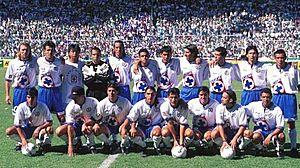
In 1997, with Luis Fernando Tena as manager, the club won the 1997 CONCACAF Champions' Cup again. They beat LA Galaxy in the final on August 24.
On December 7, 1997, Cruz Azul won the Invierno 1997 league title. They beat León in the final with a golden goal. This ended their 17-year league title drought. It also gave the club its second "continental treble." The winning moment came in extra time. León's goalkeeper Ángel Comizzo fouled striker Carlos Hermosillo in the penalty area. Hermosillo, even though he was hurt, scored the penalty kick. This won the title for Cruz Azul.
Second Drought and International Efforts (1998–2013)
In 2001, Cruz Azul played in the Copa Libertadores. They got there through a special playoff tournament. They were in Group 7 and finished first with 13 points.
In the Round of 16, Cruz Azul beat Cerro Porteño. In the quarter-finals, they faced River Plate. They drew 0–0 away and won 3–0 at home. In the semi-finals, they beat Rosario Central. This sent them to the final against Boca Juniors.
Cruz Azul lost the first game 1–0 at Estadio Azteca. But they won the second game 1–0 at La Bombonera, with Francisco Palencia scoring. The game went to a penalty shootout, which Boca Juniors won. Even though they lost, Cruz Azul was the first Mexican club to reach a Copa Libertadores final. This was a big achievement in Mexico and South America.
Challenges for the Coach (2005)
On July 16, 2005, Cruz Azul manager Rubén Omar Romano was unable to lead the team for a period. During his absence, assistant coach Isaac Mizrahi took over. After 65 days, Romano was found and safely returned. While he was away, Cruz Azul decided not to renew his contract. They offered the coaching job to Mizrahi. Romano later said he was disappointed by the club's decision.
Close Losses (2008–2013)
Between 2008 and 2013, Cruz Azul was often expected to win titles. They had good players and money. But they reached many finals, both in Mexico and internationally, and didn't win. Many of these losses happened because of late goals or very close scores. This led to people saying the club couldn't finish games. The word cruzazulear became popular around 2013. It means to lose a game even when you have a clear advantage. The Royal Spanish Academy officially recognized this word in 2020.
In the Clausura 2008 tournament, Cruz Azul finished second in the regular season. They reached the final but lost 3–2 to Santos Laguna. In the next tournament, Apertura 2008, they reached another final. They beat Pumas UNAM and Atlante in the playoffs. In the final against Toluca, Cruz Azul lost the first game 2–0. But they won the second game 2–0, making the score even. Toluca won the championship 7–6 in a penalty shootout.
Cruz Azul also reached the final of the 2008–09 CONCACAF Champions League. They lost 2–0 to Atlante. On their way to the final, they beat Pumas UNAM and Puerto Rico Islanders.
In the Clausura 2009 tournament, the club finished last. They only got 13 points in 17 games. Manager Benjamín Galindo was let go. Robert Dante Siboldi took over temporarily.
For the Apertura 2009, Cruz Azul hired Enrique Meza as head coach. They also signed important players like goalkeeper José de Jesús Corona and striker Emanuel Villa. The team finished second in the regular season. They reached the final after beating Puebla and Morelia in the playoffs. Villa was the league's top scorer with 17 goals. But Cruz Azul lost the final to Monterrey 6–4. This was their third league final loss in less than two years.
In the 2009–10 CONCACAF Champions League, Cruz Azul finished first in their group. They moved to the knockout stage. They beat Árabe Unido 4–0. Then they beat Pumas UNAM in the semi-finals. In the final against Pachuca, Cruz Azul won the first game 2–1 at home. But they lost the second game 1–0, giving up a goal in extra time. The score was tied 2–2, but Pachuca won because of the away goals rule. This meant Cruz Azul missed out on the 2010 FIFA Club World Cup.
In April 2012, the club changed its official name to Cruz Azul Fútbol Club, A.C..
During the Clausura 2013, Cruz Azul started slowly in the league. But they got better after beating América in the Copa MX semi-finals. They then won the tournament by beating Atlante in the final. After their cup win, their league performance improved. They made it to the playoffs as a strong team. In the final of the Clausura 2013 tournament, Cruz Azul faced América again in a famous Clásico Joven match. Cruz Azul won the first game and was leading 2–0 late in the second game. But América scored two quick goals in the last minutes, one by goalkeeper Moisés Muñoz. América then won the championship 4–2 in a penalty shootout.
Comeback and New Successes (2014–Present)
On April 23, 2014, Cruz Azul won its sixth CONCACAF Champions League title. They beat Toluca. This was their first trophy in 17 years. This win also qualified Cruz Azul for the 2014 FIFA Club World Cup, where they finished fourth.
Between the Apertura 2014 and Clausura 2017 tournaments, Cruz Azul did not make it to the playoffs for six seasons in a row. They returned to the playoffs in the Apertura 2017. But they were eliminated by América because América had a higher ranking. On November 27, 2017, the club announced that manager Paco Jémez would not stay for the next season.
In the Clausura 2018, Cruz Azul finished 12th and missed the playoffs. They also finished last in their Copa MX group. On May 7, 2018, Eduardo de la Torre left as sporting director. Ricardo Peláez took his place. Later that year, Cruz Azul won the Apertura 2018 Copa MX. They beat Monterrey 2–0 in the final. In the same tournament, the club reached the Liga MX final again. They faced América, just like in the Clausura 2013 final. The first game was a 0–0 draw. América won the second game 2–0. This meant Cruz Azul's league title drought continued.
In May 2020, the club president, Guillermo Álvarez Cuevas, faced serious issues. He resigned from his position in August 2020 after more than three decades as club president.
On December 6, 2020, Cruz Azul played Pumas UNAM in the Guardianes 2020 semi-finals. Cruz Azul won the first game 4–0. But they lost the second game by the same score. The total score was 4–4. Pumas UNAM went to the final because they had a higher ranking in the regular season.
After the Guardianes 2020 tournament, Cruz Azul hired Juan Reynoso as head coach for the Guardianes 2021 tournament. Reynoso was a former player who had been on the team that won the league title in 1997. Álvaro Dávila also joined as executive president. After two losses to start, Cruz Azul won 12 games in a row! This tied the Liga MX record set by León. The winning streak ended with a 1–1 draw against América. Cruz Azul finished the regular season as league leaders with 41 points. In the playoffs, Cruz Azul beat Toluca and Pachuca. They reached the final against Santos Laguna. After a 1–0 win in the first game and a 1–1 draw in the second on May 30, 2021, Cruz Azul won 2–1 overall. They won their ninth league title, ending a 23-year wait! They then beat León 2–1 in the Campeón de Campeones match on July 18, 2021. However, Cruz Azul struggled in the next tournaments. Reynoso was let go on May 18, 2022.
On May 30, 2022, Diego Aguirre became head coach. He led the club to win the 2022 Supercopa de la Liga MX. They beat Atlas on penalties after a 2–2 draw. But Aguirre was let go on August 21 after a big 7–0 loss to América. Raúl Gutiérrez took over but was also let go on February 13, 2023. Ricardo Ferretti was then hired on February 22, but he was also let go on August 7. Joaquín Moreno became interim coach and then the permanent head coach for the rest of the Apertura 2023 tournament. After finishing 16th, Moreno stepped down on December 19. He became director of the club's reserve and academy system.
On December 20, 2023, Cruz Azul hired Martín Anselmi as head coach. For the Clausura 2024, the club signed new players like Kevin Mier and Lorenzo Faravelli. After an opening loss, Cruz Azul finished second in the regular season with 33 points. They beat Pumas UNAM and Monterrey to reach the final. They faced América again. This was the sixth final between the two clubs, making it the most played final in Liga MX history. América won the title 2–1 overall after a penalty in the second game.
In the Apertura 2024, Cruz Azul started with six games without a loss. They needed only a draw in the last game to set a new Liga MX record for points in a short tournament. A late goal by Ángel Sepúlveda against Tigres UANL gave Cruz Azul a 1–1 draw. This secured a record 42 points. Cruz Azul beat Tijuana in the quarter-finals. They came back from a 3–0 loss in the first game to win 3–0 at home. In the semi-finals, they faced América. After a 0–0 draw in the first game, Cruz Azul scored late in the second game. But América got a penalty in extra time and won 4–3 overall.
For the Clausura 2025, Cruz Azul announced they would play their home games at Estadio Olímpico Universitario. On January 24, 2025, Anselmi left for Portuguese club Porto. Vicente Sánchez was named interim manager the next day and became permanent coach on February 23. The club won a record-tying seventh CONCACAF Champions Cup title under him. They beat Vancouver Whitecaps 5–0 in the final. This win also qualified them for the 2025 FIFA Intercontinental Cup and the 2029 FIFA Club World Cup. On June 6, 2025, Cruz Azul announced Sánchez's departure.
On June 16, 2025, Cruz Azul announced Nicolás Larcamón as their new head coach. He signed a two-year contract.
Team Logos and Colors
Team Logos
Cruz Azul's logo has changed over the years. But it has always shown the club's main identity since 1927. The blue cross inside a white circle and red square is a key symbol. It represents the club's history and its link to Cooperativa La Cruz Azul, S.C.L.. The cross also shows values like unity and teamwork. The cross itself is inspired by British designs.
In its early days, the logo was a simple shield with the blue cross. This cross was a strong symbol of the cooperative. As Cruz Azul became more famous, they updated their logo in 1964. It became rounder and included the full name, Club Deportivo Cruz Azul. This showed the club was becoming more professional.
The logo changed again in the early 1970s after Cruz Azul won its first league title. Stars were added above the cross to show these wins. By 1973, the logo had three stars. This started a tradition of adding a star for each league title. This way, the logo showed the club's achievements. Over the years, the logo became cleaner and more modern. By 1980, the stars were set in a standard way. This made the logo easy to recognize.
In 1997, Cruz Azul made a big change to its logo. It became a circular shape, looking modern and unique. The word "Mexico" was added around the outside. This showed the club's pride in representing the country. This design stayed for over 20 years.
In 2021, Cruz Azul changed its logo to celebrate winning its ninth Liga MX title. This ended a 23-year wait! A ninth star was added around the logo. This showed the club's big win and strength. The blue cross stayed the same in the middle. The next year, "Club de Futbol" replaced "Deportivo" around the outside. The stars around the logo were removed. This made the design simpler. The current logo looks to the future while still honoring the club's history.
Team Colors
Cruz Azul's colors are red, white, and blue. These colors honor the British history of the company. The blue cross means strength and unity. The red and white colors also show the club's history. These colors are deeply connected to the cooperative's values. They represent the organization's commitment to working together. The blue, white, and red also connect to the Santa Cruz (Holy Cross).
Uniform Suppliers and Sponsors
| Period | Uniform manufacturer | Shirt sponsor (main) | Other sponsors |
|---|---|---|---|
| 1994–1997 | Azul Sport | Cemento Cruz Azul | None |
| 1997–1998 | Fila | Lada | |
| 1998–2001 | Pepsi and Telmex | ||
| 2002–2004 | Umbro | ||
| 2004–2008 | Coca-Cola and Telcel | ||
| 2008–2009 | Coca-Cola, Telcel and Sony | ||
| 2009–2010 | Powerade, Telcel and Sony | ||
| 2010–2011 | Coca-Cola and Telcel | ||
| 2011–2013 | Coca-Cola, Telcel, Tecate and Volaris | ||
| 2013–2014 | Coca-Cola, Telcel, Tecate and Scotiabank | ||
| 2014–2017 | Under Armour | Boing!, Scotiabank, Telcel and Tecate | |
| 2017–2018 | Scotiabank, Telcel and Tecate | ||
| 2018 | Caliente | ||
| 2019–2023 | Joma | ||
| 2023–2024 | Pirma | ||
| 2024 | Caliente and Cemix | ||
| 2025 | Caliente, Cemix and Bankaool | ||
| 2025– | Novibet, Nikko Auto-Parts, Cemix and Bankaool |
Team Nicknames

Cruz Azul has many nicknames from its history:
- Celestes (Sky Blues): This name came from the light blue uniforms the team wore in the late 1960s and early 1970s. Fans and media called the players Celestes because their uniforms looked like the sky. This name is still used today.
- Cementeros (Cement Workers): This nickname comes from Cruz Azul's connection to the Cooperativa La Cruz Azul. The team was started by workers from the company. Over time, the name came to mean not just company workers, but all construction workers.
- Liebres (Hares): In the club's early years in the top league (mid-1960s), Cruz Azul played very fast and strong. Their mostly white uniforms made fans compare them to hares, which were common in the area. This nickname became popular. A cartoon hare is often used as the team's mascot. While some people think it's a rabbit, the club has said it's officially a hare.
- La Máquina (The Machine / The Locomotive): This nickname has a few origins. One idea is that it comes from the railway system used to carry cement from the Cruz Azul factory to Mexico City. After moving to the capital, Cruz Azul became one of the best teams in Mexican football in the 1970s. Their strength and consistency made people compare them to a powerful locomotive. Another idea is that the name might have been inspired by Argentina's River Plate, who were also called La Máquina in the 1940s. Sports journalist Ángel Fernández Rugama helped make the nickname popular for Cruz Azul. Other versions of the name include La Máquina Celeste (The Sky Blue Machine) and La Máquina Azul (The Blue Machine).
Home Stadium
Cruz Azul first played at Estadio 10 de Diciembre in Jasso, Hidalgo, from 1964 to 1971. This stadium held 17,000 people. The club won its first league titles there in 1968–69 and 1970. Even after they left in 1971, it was still used for some cup and league games.
In 1971, Cruz Azul moved to the Estadio Azteca in Mexico City. They had many great successes there, including five league titles. They briefly left in 1996 for the Estadio Azul, where they played until 2018. The team returned to the Azteca in 2018 and won their ninth league title there in 2021.
The Estadio Azul, in Mexico City's Colonia Nápoles, was Cruz Azul's home from 1996 to 2018. It was a special place for the club, even though they never won a league title there. Due to renovations at the Azteca for the 2026 FIFA World Cup, the team temporarily returned to the Estadio Azul (now called the Estadio Ciudad de los Deportes) in 2024.
Cruz Azul played at Ciudad de los Deportes for one year. Since 2025, the team has moved to the Estadio Olímpico Universitario. This was due to issues at the Colonia Nápoles stadium.
The team's training facilities, Instalaciones La Noria, are in Xochimilco. The team has said they want to build a new stadium, but plans are still being worked out.
Fan Support
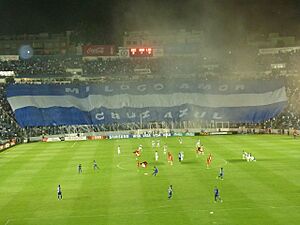
A 2021 survey showed that Cruz Azul has the third-largest fan base in Mexico. They are behind Guadalajara and América, but ahead of Pumas UNAM. About 10.9% of Mexican football fans, or around 14 million people, support them. In the past, mostly cement workers from Cooperativa La Cruz Azul, S.C.L. supported the club. After the team moved up to the top league in the 1960s, their fan base grew a lot. The 1970s, when Cruz Azul won six league titles, was a huge time for their popularity. This made them one of the most supported clubs in the country.
The club became famous in Mexico for not winning a league title between 1997 and 2021. This was called the "Cruz Azul curse." It was like the "Neverkusen" label for German club Bayer Leverkusen. Or the "Curse of the Bambino" for the MLB's Boston Red Sox. And the "Curse of the Billy Goat" for the Chicago Cubs. These teams, even with good players, often lost in important games. Cruz Azul's "curse" finally ended when they won the Guardianes 2021 final against Santos Laguna on May 30, 2021. They won 2–1 overall. The long wait included six lost finals and many other tough playoff losses. It also led to the Mexican Spanish word cruzazulear. This means to lose a game in a dramatic way, even when you are winning.
The club used to have its own official cheerleading group called Las Celestes. They were part of the club since 2004. For years, they performed before games and at halftime. They were a special tradition for the club and fans. Cruz Azul was the only Mexican team to have official cheerleaders. However, Las Celestes are no longer active today.
Cruz Azul has very passionate fans. La Sangre Azul is their only official supporters' group. It started in January 2001. They are known for their strong support, creating an exciting atmosphere at games. They use chants, banners, and displays to unite fans. In March 2015, the group lost club support due to some incidents. But in recent seasons, their relationship with the new club board has improved. La Sangre Azul is a key part of Cruz Azul's fan culture.
Main Rivals
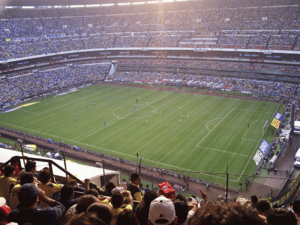
Cruz Azul's biggest rival is América. Their games are known as the Clásico Joven (meaning "Young Classic"). This rivalry started in the early 1970s. Both clubs were very strong then and often played in league finals. Their first big final was in the 1971–72 season, which Cruz Azul won 4–1. This made the rivalry very important. It grew even more in the 1980s and 1990s with many close games. The rivalry became very exciting again in the Clausura 2013 finals. América made an amazing comeback to tie the game late and then won on penalties. This is one of the most memorable games in Liga MX history. As of 2025, the Clásico Joven has had the most finals between two clubs in Mexican football, with seven championship matches.
The rivalry also comes from social differences. América is often seen as a club for the wealthy. This is because it is owned by the media company Televisa. Cruz Azul, however, is linked to the working class. It started as a team for the cement company workers. This is why Cruz Azul and its fans are sometimes called Los Albañiles (meaning "the bricklayers"). Many players and coaches have played for both teams, which makes the rivalry even stronger. For example, Raúl Cárdenas coached both clubs in the 1970s. Carlos Hermosillo is the top scorer in Clásico Joven history, with 15 goals (seven for América and eight for Cruz Azul). Games between these two teams are always highly anticipated. They draw large crowds and national media attention. Both clubs share the Estadio Azteca for much of their history, making their matches feel like a local derby. As of May 2025, the clubs have played 203 times. América has 74 wins, Cruz Azul has 61 wins, and 68 games have been draws.
Team Staff
Management Team
Source: Cruz Azul
Coaching Staff
Source: Liga MX
Players
First-Team Squad
|
|
Players on Loan
|
|
Other Players Under Contract
|
Reserve and Academy Teams
- Cruz Azul Lagunas
This is a reserve team that plays in the Liga TDP (Group II). This is the fourth level of Mexican football.
Former Teams
- Cruz Azul Hidalgo
A reserve team that played in the Primera División "A" from 1992 to 2003 and again from 2006 to 2014. They also played in Liga Premier from 2014 to 2021.
- Cruz Azul Oaxaca
A reserve team that played in the Primera División "A" from 2003 to 2006.
- Cruz Azul Jasso
A reserve team that played in the Segunda División from 2006 to 2015.
- Cruz Azul Premier
A reserve team that played in the Segunda División/Liga Premier from 2015 to 2018.
Top Players and Records
Top Scorers in Tournaments
|
|
All-Time Records
|
Managers
Manager History
| Name | Period | Notes |
|---|---|---|
| 1961–62 | First coach in Cruz Azul's professional history. | |
| 1962–66 | Helped the team move up to the Primera División in 1963–64. | |
| 1966 | ||
| 1966–75 | Won five league titles, three CONCACAF Champions' Cups, one national cup, and two Campeón de Campeones titles. | |
| 1975–76 | ||
| 1976 | ||
| 1976 | ||
| 1977–82 | Won two league titles. | |
| 1982 | ||
| 1982–83 | ||
| 1983–86 | ||
| 1986–88 | ||
| 1988 | ||
| 1988–90 | ||
| 1990 | ||
| 1990–92 | ||
| 1 July 1992 – 31 December 1992 | ||
| 1 July 1992 – 29 January 1995 | Second time coaching the club. | |
| 1995–96 | Won the 1996 CONCACAF Champions' Cup. | |
| 1 July 1996 – 9 March 1997 | Won the second national cup title. | |
| 1997 | ||
| 1997–2000 | Won Cruz Azul's eighth league title in 1997 and the 1997 CONCACAF Champions' Cup. | |
| 31 March 2000 – 31 December 2002 | Led Cruz Azul to the Copa Libertadores final in 2001. | |
| 1 January 2003 – 7 March 2003 | ||
| 15 March 2003 – 7 March 2004 | ||
| 12 March 2004 – 17 October 2004 | ||
| 19 October 2004 – December 2004 | ||
| January 2005 – 15 December 2005 | Was unable to lead the team for 65 days during his time. | |
| 15 December 2005 – 20 May 2007 | ||
| 1 July 2007 – 30 June 2008 | Led Cruz Azul to a final after almost 10 years. | |
| 1 July 2008 – 30 June 2009 | Lost two finals with Cruz Azul. | |
| 1 July 2009 – 30 June 2012 | Led the team to another league final and a CONCACAF Champions League final. | |
| 1 July 2012 – 3 December 2013 | Won the third national cup title. | |
| 4 December 2013 – 19 May 2015 | Won the 2013–14 CONCACAF Champions League. | |
| 1 June 2015 – 28 September 2015 | ||
| 2 October 2015 – 22 October 2016 | ||
| 28 November 2016 – 27 November 2017 | Led Cruz Azul to their first playoff appearance since 2014. | |
| 5 December 2017 – 2 September 2019 | Won the fourth national cup title and the 2019 Supercopa MX. Led Cruz Azul to a league final. | |
| 6 September 2019 – 11 December 2020 | Won the first Leagues Cup. | |
| 7 January 2021 – 19 May 2022 | Tied the league record for consecutive wins (12). Won the club's ninth league title in 2021. | |
| 30 May 2022 – 21 August 2022 | Won the first Supercopa de la Liga MX. | |
| 22 August 2022 – 13 February 2023 | ||
| 22 February 2023 – 7 August 2023 | ||
| 8 August 2023 – 19 December 2023 | ||
| 20 December 2023 – 24 January 2025 | Broke the record for most league points (42) in short tournaments. | |
| 25 January 2025 – 6 June 2025 | Won the 2025 CONCACAF Champions Cup. | |
| 16 June 2025 – Present |
Club Achievements
Cruz Azul won its first major title in the 1968–69 season. They won the Mexican Primera División just five years after moving up to the top league. During their "golden era" in the 1970s, Cruz Azul won six league titles. This earned them the nickname La Máquina (The Machine) for their strong playing style. The club added two more league titles in later years, in 1997 and 2021. The 2021 win ended a 23-year wait for a championship. In Mexico, Cruz Azul has also won the Copa MX four times and the Campeón de Campeones trophy three times. They also won the Supercopa MX in 2019 and the Supercopa de la Liga MX in 2022.
Internationally, Cruz Azul is one of Mexico's most successful clubs. They have won the CONCACAF Champions' Cup/Champions League seven times. This is the most wins in the region, shared with América. In 2001, the club became the first Mexican and CONCACAF team to reach the final of the Copa Libertadores. They lost closely to Boca Juniors on penalties.
Cruz Azul has also played in the FIFA Club World Cup and the Copa Interamericana. They are one of the most supported and important football clubs in the Americas.
National Titles
| Type | Competition | Titles | Winning editions | Runners-up |
|---|---|---|---|---|
| Primera División/Liga MX | 9 | 1968–69, México 1970, 1971–72, 1972–73, 1973–74, 1978–79, 1979–80, Invierno 1997, Guardianes 2021 | 1969–70, 1980–81, 1986–87, 1988–89, 1994–95, Invierno 1999, Clausura 2008, Apertura 2008, Apertura 2009, Clausura 2013, Apertura 2018, Clausura 2024 | |
| Copa México/Copa MX | 4 | 1968–69, 1996–97, Clausura 2013, Apertura 2018 | 1973–74, 1987–88 | |
| Campeón de Campeones | 3 | 1969, 1974, 2021 | 1972 | |
| Supercopa MX | 1s | 2019 | – | |
| Supercopa de la Liga MX | 1s | 2022 | – | |
| Promotion League | Segunda División | 1 | 1963–64 | – |
International Titles
| Type | Competition | Titles | Winning editions | Runners-up |
|---|---|---|---|---|
| Intercontinental (North & South America) |
Copa Interamericana | 0 | – | 1971 |
Continental (North America) |
CONCACAF Champions Cup/Champions League | 7s | 1969, 1970, 1971, 1996, 1997, 2013–14, 2025 | 2008–09, 2009–10 |
| Continental (South America) | CONMEBOL Libertadores | 0 | – | 2001 |
Regional Titles
| Type | Competition | Titles | Winning editions | Runners-up |
|---|---|---|---|---|
(MLS & Liga MX) |
Leagues Cup | 1s | 2019 | – |
| Campeones Cup | 0 | – | 2021 |
- record
- s shared record
Friendly Titles
- Torneo Almería: 1979
- Torneo Burgos: 1980
- Cuadrangular Azteca: 1981
- Triangular Los Ángeles: 1991
- Cuadrangular Querétaro: 1992
- Torneo Monterrey 400: 1996
- Copa Pachuca: 1997, 1998, 2002, 2006, 2007
- Copa 5 de Mayo: 2004
- Copa Panamericana DirecTV: 2007
- Copa Amistad: 2007
- Copa Aztex: 2009
- Copa Socio MX: 2015
- Supercopa Tecate: 2017
- Dynamo Charities Cup: 2017
- Copa GNP por México: 2020
- Copa Sky: 2022
- Copa Fundadores: 2024
Doubles and Trebles
- Doubles (winning two major titles in one season)
- League and Copa México (2): 1968–69, 1996–97
- League and CONCACAF Champions' Cup (3): 1968–69, 1970, 1997
- Trebles (winning three major titles in one season)
- Liga MX, Copa México and CONCACAF Champions' Cup (2): 1968–69, 1996–97
Club Records
Team Statistics and Records
- Cruz Azul is the only CONCACAF club to win the North American treble twice. They won the Primera División, Copa México, and CONCACAF Champions' Cup in 1969 and 1997.
- Cruz Azul has the third-most international titles among Mexican clubs. They have seven titles in the CONCACAF Champions Cup/League. They were also runners-up twice in 2009 and 2010. They were runners-up once in the Copa Libertadores in 2001 and in the Copa Interamericana in 1971.
- Cruz Azul holds the record for most titles in the CONCACAF Champions Cup/League, with seven. They share this record with América.
- Cruz Azul holds the record for most consecutive wins in the Primera División: 12 wins in the Guardianes 2021. They share this record with León.
- Cruz Azul is the second Mexican team with the most playoff games played, with 237 matches.
- Cruz Azul was the first Mexican team to win a final with a "golden goal" (in 1997).
- Cruz Azul has played in 18 playoff finals, winning 7 league championships. They also hold the record for the most playoff final runner-up finishes, with 11.
- Cruz Azul is one of three teams in the Primera División to win league titles in three seasons in a row (1971–72, 1972–73, and 1973–74).
- Cruz Azul was the fastest team to become champions after being promoted. They won the league just five years after moving up in the 1968–69 season.
- Cruz Azul was the fastest team to win seven league titles. They did this in only fifteen years of playing in Mexico's Primera División.
Amateur Era (1927–1961)
During the amateur era, only employees from the Cruz Azul cement factory played for the team. This showed the strong link between the club and its company. The team often won by large scores against local teams, showing how dominant they were.
- Consecutive titles in the Primera División Amateur del Estado de Hidalgo: Cruz Azul won 15 titles in a row (from 1935 to 1960). This was one of their biggest achievements.
- First recorded match: Cruz Azul's first game was against Jilotepec, and they won 16–0.
- Winning streak: Cruz Azul had a very long winning streak during their time dominating the amateur league.
Professional Era (Since 1961)
- Seasons in Primera División: 61. They have never been moved down to a lower league since their first season in 1964–65.
- Seasons in Segunda División: 3
- Playoff (Liguilla) for the title: 62 times
- Final for the title: 18 times (1971–72, 1972–73, 1973–74, 1978–79, 1979–80, 1980–81, 1986–87, 1988–89, 1994–95, Invierno 1997, Invierno 1999, Clausura 2008, Apertura 2008, Apertura 2009, Clausura 2013, Apertura 2018, Guardianes 2021, Clausura 2024)
- 1st place finishes: 15 times
- Moved down to Liga de Expansión MX: 0 times
- Moved up to the Primera División: 1 time (in the 1963–64 season)
- Most common final position: 1st place (15 times)
- Best place in Primera División:
- In long tournaments: 1st place (1968–69, México 1970, 1971–72, 1972–73, 1973–74, 1978–79, 1995–96)
- In short tournaments: 1st place (Invierno 1998, Invierno 2000, Apertura 2006, Apertura 2010, Clausura 2014, Apertura 2018, Guardianes 2021, Apertura 2024)
- Worst place in Primera División:
- In long tournaments: 18th out of 20 teams (in the 1989–90 season)
- In short tournaments: 18th out of 18 teams (Clausura 2009)
- Highest score achieved:
- Highest score against:
- Most points in a season:
- In long tournaments: 57 (in the 1978–79 season)
- In short tournaments: 42 (Apertura 2024) (a Mexican football record for a 17-game tournament)
- Longest streak of games without losing: 19 (from matchday 18 to semi-final second-leg in the 1973–74 season)
- Longest undefeated streak at home: 47 games (1978–1980) (a Mexican football record)
- Most goals scored in a season:
- In long tournaments: 91 (in the 1994–95 season)
- In short tournaments: 41 (Invierno 1998)
- Most wins in a season: 22 (in the 1971–72 season)
- Most draws in a season: 17 (in the 1989–90 season)
- Most defeats in a season: 13 (in the 1982–83 and 1989–90 seasons)
- Consecutive wins in a season: 12 (Guardianes 2021) (a Mexican football record)
- Most consecutive draws: 5 (in the 1973–74 season)
- Most consecutive games without a win: 11 (in the 1965–66 season)
- Fewest wins in a season: 2 (Clausura 2009)
- Fewest draws in a season: 0 (Apertura 2009)
- Fewest defeats in one season: 1 (PRODE 85, Invierno 1998 and Apertura 2024)
- Player with the most goals in a season:
 Carlos Hermosillo, 35 (in the 1994–95 season)
Carlos Hermosillo, 35 (in the 1994–95 season) - Most successful manager:
 Raúl Cárdenas, won 11 titles with the club.
Raúl Cárdenas, won 11 titles with the club. - Most successful player:
 Fernando Bustos, won 13 titles with the club.
Fernando Bustos, won 13 titles with the club.
See also
 In Spanish: Club de Fútbol Cruz Azul para niños
In Spanish: Club de Fútbol Cruz Azul para niños


